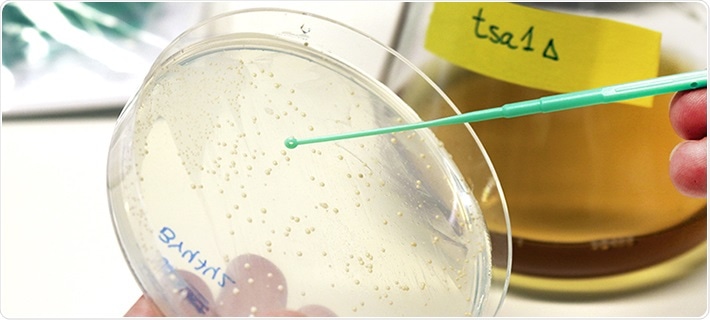High levels of reactive oxygen species, called oxidants, are detrimental to cells in all organisms and have been associated with aging.

Yeast can be grown on both solid and liquid nutrition medium and is a good model system for studying ageing. Image Credit: Martina Butorac.
However, a new study from Chalmers University of Technology has now demonstrated that low concentrations of the oxidant hydrogen peroxide can activate an enzyme that can actually slow down the aging process in yeast cells.
Antioxidants, like vitamins C and E, offer a major benefit—they neutralize reactive oxygen, or oxidants, which may otherwise react with key molecules found in the body and impair their biological functions.
Oxidants in larger amounts can cause serious damage to proteins, DNA, and cell membranes, for instance. Therefore, human cells have developed strong defense mechanisms to eliminate these oxidants, which are formed in humans’ normal metabolism.
Earlier, it was assumed that oxidants were only harmful but now they are also known to have positive functions. The latest study from the Chalmers University of Technology demonstrated that the popular oxidant hydrogen peroxide can, in fact, slow down the aging of yeast cells.
Hydrogen peroxide is essentially a chemical that is utilized for hair and tooth whitening, among many other things. This chemical is also one of the oxidants that form in human metabolism, which at higher concentrations, is quite harmful.
Less food gives longer life
The researchers from the Chalmers University of Technology examined the enzyme called Tsa1, which belongs to a group of antioxidants known as peroxiredoxins.
Previous studies of these enzymes have shown that they participate in yeast cells' defences against harmful oxidants. But the peroxiredoxins also help extend the life span of cells when they are subjected to calorie restriction. The mechanisms behind these functions have not yet been fully understood.”
Mikael Molin, Study Lead, Department of Biology and Biological Engineering, Chalmers University of Technology
Reduced calorie intake is already known to considerably increase the life span of a wide range of organisms, from monkeys to yeast. Many research teams, including the team of Mikael Molin, have also demonstrated that stimulation of peroxiredoxin activity is actually the one that slows down cell aging in organisms, like worms, flies, and yeast, when they receive fewer calories than usual through their food.
Now we have found a new function of Tsa1. Previously, we thought that this enzyme simply neutralises reactive oxygen species. But now we have shown that Tsa1 actually requires a certain amount of hydrogen peroxide to be triggered to participate in the process of slowing down the ageing of yeast cells.”
Cecilia Picazo, Postdoctoral Researcher, Division of Systems and Synthetic Biology, Chalmers University of Technology
Unexpectedly, the study demonstrated that the Tsa1 enzyme does not influence hydrogen peroxide levels in aged yeast cells. On the other hand, this enzyme uses slight amounts of hydrogen peroxide to decrease the activity of a key signaling pathway when cells are receiving fewer calories.
The impact of this eventually slows down cell division and processes associated with the development of the cells’ building blocks. Moreover, the cells’ defenses against stress are activated—which causes them to age more gradually.
Could lead to drugs that mimic the positive effects of calorie restriction
Signal pathways which are affected by calorie intake may play a central role in ageing by sensing the status of many cellular processes and controlling them. By studying this, we hope to understand the molecular causes behind why the occurrence of many common diseases such as cancer, Alzheimer's disease, and diabetes shows a sharp increase with age.”
Mikael Molin, Study Lead, Department of Biology and Biological Engineering, Chalmers University of Technology
Now, since researchers have come closer to interpreting the mechanisms behind how oxidants, this fact can in fact slow down the process of aging and may result in new studies, for instance searching for peroxiredoxin-stimulating medications, or validating whether age-related diseases can be slowed by other medications that improve the positive effects of oxidants in the body.
Source:
Journal reference:
Roger, F., et al. (2020) Peroxiredoxin promotes longevity and H2O2-resistance in yeast through redox-modulation of protein kinase A. eLife. doi.org/10.7554/eLife.60346.